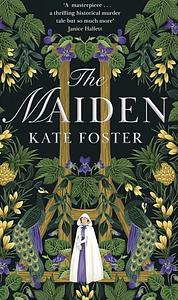Take a photo of a barcode or cover
I didn’t enjoy the vulgar language/tone with which large sections were written. I understand it being concurrent with the way in which those being written about would have spoke but I just didn’t enjoy it. I also found the jumping of dates and people difficult to follow.
dark
emotional
reflective
sad
medium-paced
Plot or Character Driven:
Character
Strong character development:
No
Loveable characters:
Complicated
Diverse cast of characters:
No
Flaws of characters a main focus:
Yes
Moderate: Confinement, Death, Physical abuse, Rape, Sexual assault, Abortion, Murder, Classism
dark
mysterious
sad
medium-paced
Plot or Character Driven:
Character
Loveable characters:
No
Diverse cast of characters:
No
Flaws of characters a main focus:
Yes
emotional
mysterious
reflective
tense
fast-paced
Plot or Character Driven:
Character
Strong character development:
Yes
Loveable characters:
Yes
Diverse cast of characters:
No
Flaws of characters a main focus:
No
dark
emotional
mysterious
tense
fast-paced
Plot or Character Driven:
A mix
Strong character development:
Yes
Loveable characters:
Yes
Diverse cast of characters:
No
Flaws of characters a main focus:
Yes
adventurous
dark
emotional
mysterious
tense
Plot or Character Driven:
A mix
Wow. I was hesitant to read this, given I usually don’t like historic fiction - especially if the story is set in an era I studied. But because the plot seemed character-focused and had an interesting setting, and the book itself got nominated for a bunch of awards, I decided to give it a go.
After the first two chapters or so, I could not put this book down. The characters were all so well-written; very flawed and products of their time, yet they all had something going for them regardless. The author is very clear that this is a work of fiction based on real-life events, and that she tried to have a journalistic perspective over events. She made up the story by filling in the gaps. And I think this awareness is key. So often with historic fiction the characters are seen through a modern lens, which means women keep commenting about living in a men’s world and their desire to escape from it. That was done a lot more subtly here. The women didn’t consider a life without men, but considered how they could tailor their life with men in a way that suited their needs. It wasn’t a feministic story of powerful women rising up against their oppressors, but a story of women trying to survive, by making choices out of desperation.
The two perspectives worked really well for me, and through the writing and characters themselves we caught a glimpse of the differences between rich and poor as well. Christian notes, for example, absent-mindedly that she’s never given a thought to the working class, because she doesn’t see them. Meanwhile Violet sees the upper classes as people to be used for their wealth, knowing they’d never care for her. The writing itself is gorgeous too. Violet speaks with a working class tone (although this does seem to fade gradually, as she grows too) and Christian speaks as someone of her station would. There’s some beautiful sentences here. The final chapter is beautifully written and wraps everything up perfectly. On top of all that, the murder mystery itself only unfolds in the last few chapters, leaving you guessing as you read. I kept wanting to continue reading this, and when I did I felt I had to savour some of the sentences as I did. That’s the sign of a great book to me.
This is a great story about gender and class, ánd a great example of how to write historic fiction for a modern audience. The author really dove into the mind of 17th century Scottish women and built up her story from there, making the story feel really realistic and totally plausible. This book to me proves you can write historic fiction that gives the agency back to women, without making it unrealistic or non-historical. For that alone I give this 5 stars.
After the first two chapters or so, I could not put this book down. The characters were all so well-written; very flawed and products of their time, yet they all had something going for them regardless. The author is very clear that this is a work of fiction based on real-life events, and that she tried to have a journalistic perspective over events. She made up the story by filling in the gaps. And I think this awareness is key. So often with historic fiction the characters are seen through a modern lens, which means women keep commenting about living in a men’s world and their desire to escape from it. That was done a lot more subtly here. The women didn’t consider a life without men, but considered how they could tailor their life with men in a way that suited their needs. It wasn’t a feministic story of powerful women rising up against their oppressors, but a story of women trying to survive, by making choices out of desperation.
The two perspectives worked really well for me, and through the writing and characters themselves we caught a glimpse of the differences between rich and poor as well. Christian notes, for example, absent-mindedly that she’s never given a thought to the working class, because she doesn’t see them. Meanwhile Violet sees the upper classes as people to be used for their wealth, knowing they’d never care for her. The writing itself is gorgeous too. Violet speaks with a working class tone (although this does seem to fade gradually, as she grows too) and Christian speaks as someone of her station would. There’s some beautiful sentences here. The final chapter is beautifully written and wraps everything up perfectly. On top of all that, the murder mystery itself only unfolds in the last few chapters, leaving you guessing as you read. I kept wanting to continue reading this, and when I did I felt I had to savour some of the sentences as I did. That’s the sign of a great book to me.
This is a great story about gender and class, ánd a great example of how to write historic fiction for a modern audience. The author really dove into the mind of 17th century Scottish women and built up her story from there, making the story feel really realistic and totally plausible. This book to me proves you can write historic fiction that gives the agency back to women, without making it unrealistic or non-historical. For that alone I give this 5 stars.
slow-paced
Plot or Character Driven:
A mix
Strong character development:
Complicated
Loveable characters:
Complicated
Diverse cast of characters:
No
Flaws of characters a main focus:
Yes
challenging
dark
mysterious
reflective
sad
slow-paced
Plot or Character Driven:
Character
Strong character development:
Yes
Loveable characters:
No
Diverse cast of characters:
No
Flaws of characters a main focus:
Yes
adventurous
dark
emotional
mysterious
sad
medium-paced
dark
emotional
reflective
medium-paced
Plot or Character Driven:
A mix
Strong character development:
Yes
Loveable characters:
Complicated
Diverse cast of characters:
Complicated
Flaws of characters a main focus:
Yes



